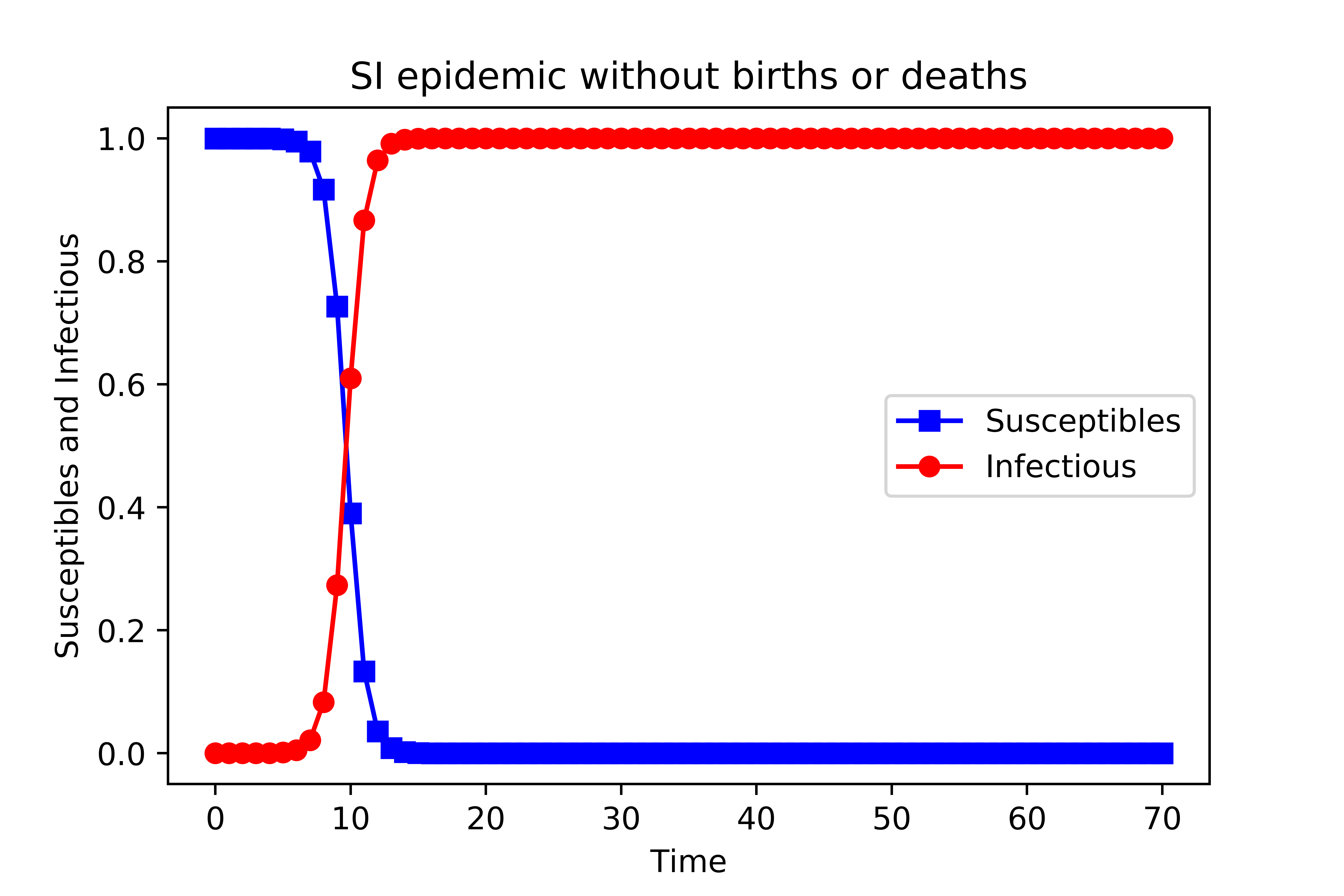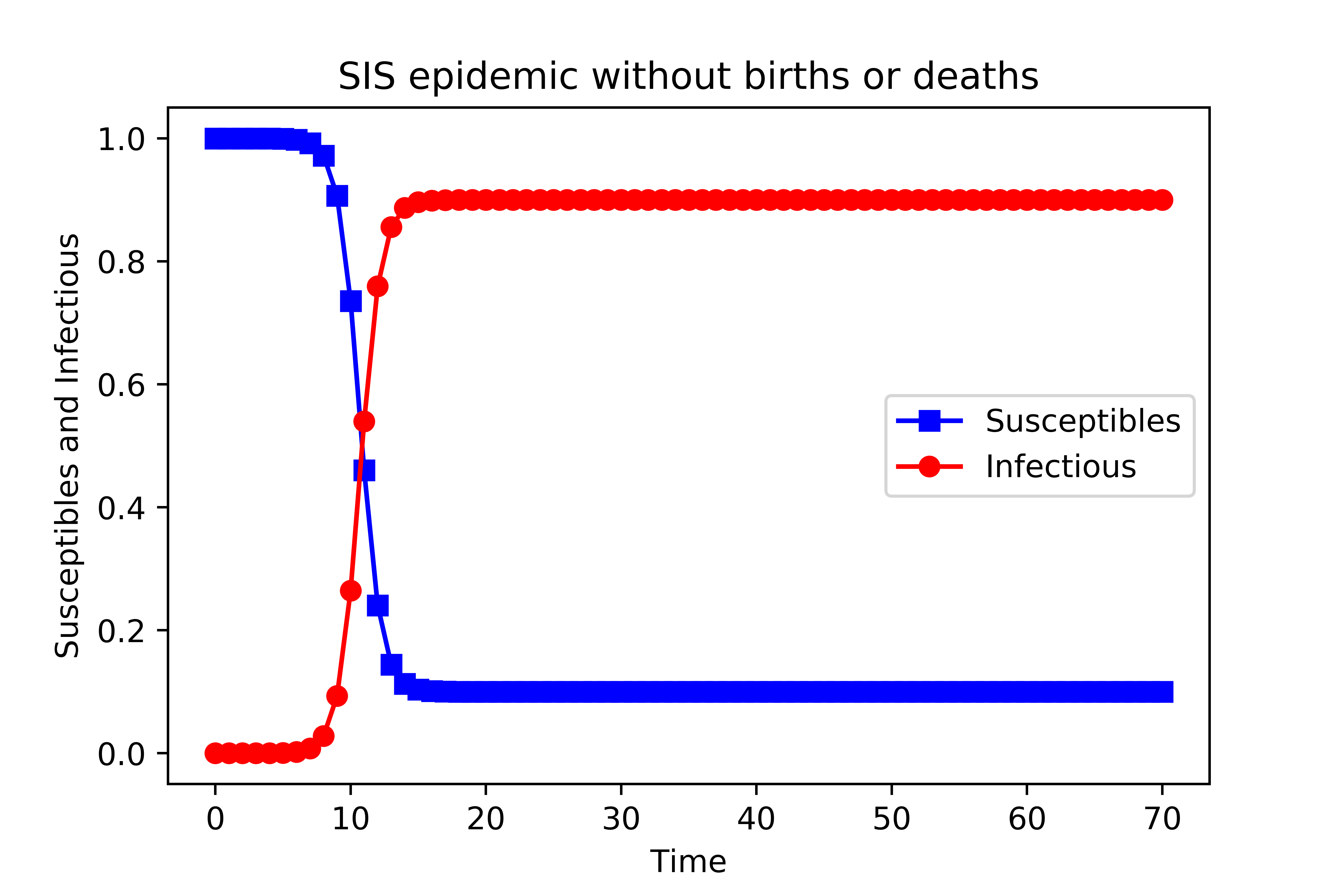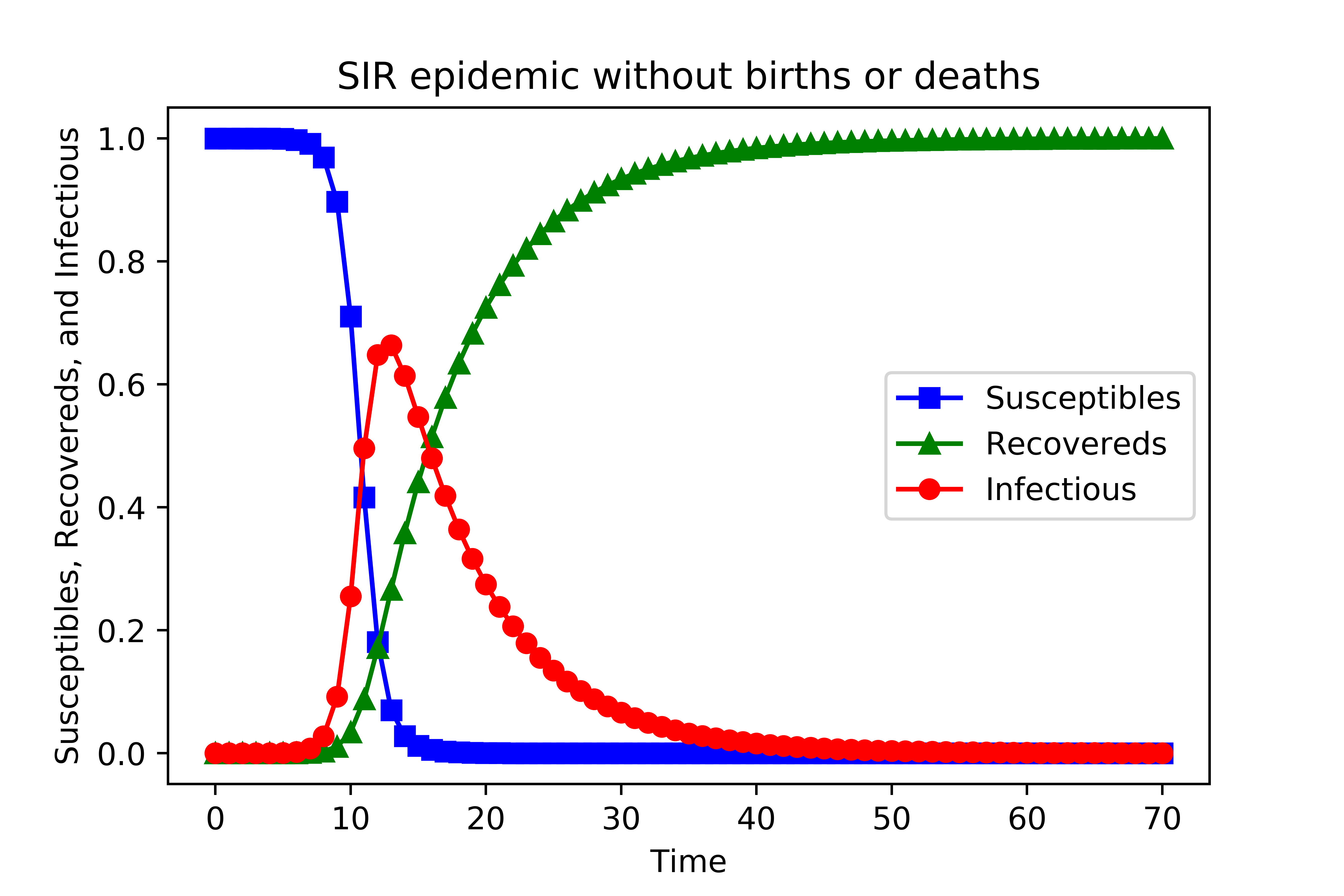基本的传染病模型:SI、SIS、SIR及其Python代码实现
本文主要参考博客:http://chengjunwang.com/en/2013/08/learn-basic-epidemic-models-with-python/。该博客有一些笔误,并且有些地方表述不准确,推荐大家阅读Albert-Laszlo Barabasi写得书Network Science,大家可以在如下网站直接阅读传染病模型这一章:http://barabasi.com/networksciencebook/chapter/10#contact-networks。Barabasi是一位复杂网络科学领域非常厉害的学者,大家也可以在他的官网上查看作者的一些相关工作。
下面我就直接把SIS模型和SIR模型的代码放上来一起学习一下。我的Python版本是3.6.1,使用的IDE是Anaconda3。Anaconda3这个IDE我个人推荐使用,用起来很方便,而且提供了Jupyther Notebook这个很好的交互工具,大家可以尝试一下,可在官网下载:https://www.continuum.io/downloads/。
在Barabasi写得书中,有两个Hypothesis:1,Compartmentalization; 2, Homogenous Mixing。具体看教材。
默认条件:1, closed population; 2, no births; 3, no deaths; 4, no migrations.
1. SI model
# -*- coding: utf-8 -*- import scipy.integrate as spi
import numpy as np
import pylab as pl beta=1.4247
"""the likelihood that the disease will be transmitted from an infected to a susceptible
individual in a unit time is β"""
gamma=0
#gamma is the recovery rate and in SI model, gamma equals zero
I0=1e-6
#I0 is the initial fraction of infected individuals
ND=70
#ND is the total time step
TS=1.0
INPUT = (1.0-I0, I0) def diff_eqs(INP,t):
'''The main set of equations'''
Y=np.zeros((2))
V = INP
Y[0] = - beta * V[0] * V[1] + gamma * V[1]
Y[1] = beta * V[0] * V[1] - gamma * V[1]
return Y # For odeint t_start = 0.0; t_end = ND; t_inc = TS
t_range = np.arange(t_start, t_end+t_inc, t_inc)
RES = spi.odeint(diff_eqs,INPUT,t_range)
"""RES is the result of fraction of susceptibles and infectious individuals at each time step respectively"""
print(RES) #Ploting
pl.plot(RES[:,0], '-bs', label='Susceptibles')
pl.plot(RES[:,1], '-ro', label='Infectious')
pl.legend(loc=0)
pl.title('SI epidemic without births or deaths')
pl.xlabel('Time')
pl.ylabel('Susceptibles and Infectious')
pl.savefig('2.5-SI-high.png', dpi=900) # This does increase the resolution.
pl.show()
结果如下图所示

在早期,受感染个体的比例呈指数增长, 最终这个封闭群体中的每个人都会被感染,大概在t=16时,群体中所有个体都被感染了。
2. SIS model
# -*- coding: utf-8 -*- import scipy.integrate as spi
import numpy as np
import pylab as pl beta=1.4247
gamma=0.14286
I0=1e-6
ND=70
TS=1.0
INPUT = (1.0-I0, I0) def diff_eqs(INP,t):
'''The main set of equations'''
Y=np.zeros((2))
V = INP
Y[0] = - beta * V[0] * V[1] + gamma * V[1]
Y[1] = beta * V[0] * V[1] - gamma * V[1]
return Y # For odeint t_start = 0.0; t_end = ND; t_inc = TS
t_range = np.arange(t_start, t_end+t_inc, t_inc)
RES = spi.odeint(diff_eqs,INPUT,t_range) print(RES) #Ploting
pl.plot(RES[:,0], '-bs', label='Susceptibles')
pl.plot(RES[:,1], '-ro', label='Infectious')
pl.legend(loc=0)
pl.title('SIS epidemic without births or deaths')
pl.xlabel('Time')
pl.ylabel('Susceptibles and Infectious')
pl.savefig('2.5-SIS-high.png', dpi=900) # This does increase the resolution.
pl.show()
运行之后得到结果如下图:

由于个体被感染后可以恢复,所以在一个大的时间步,上图是t=17,系统达到一个稳态,其中感染个体的比例是恒定的。因此,在稳定状态下,只有有限部分的个体被感染,此时并不意味着感染消失了,而是此时在任意一个时间点,被感染的个体数量和恢复的个体数量达到一个动态平衡,双方比例保持不变。请注意,对于较大的恢复率gamma,感染个体的数量呈指数下降,最终疾病消失,即此时康复的速度高于感染的速度,故根据恢复率gamma的大小,最终可能有两种可能的结果。
3. SIR model
# -*- coding: utf-8 -*- import scipy.integrate as spi
import numpy as np
import pylab as pl beta=1.4247
gamma=0.14286
TS=1.0
ND=70.0
S0=1-1e-6
I0=1e-6
INPUT = (S0, I0, 0.0) def diff_eqs(INP,t):
'''The main set of equations'''
Y=np.zeros((3))
V = INP
Y[0] = - beta * V[0] * V[1]
Y[1] = beta * V[0] * V[1] - gamma * V[1]
Y[2] = gamma * V[1]
return Y # For odeint t_start = 0.0; t_end = ND; t_inc = TS
t_range = np.arange(t_start, t_end+t_inc, t_inc)
RES = spi.odeint(diff_eqs,INPUT,t_range) print(RES) #Ploting
pl.plot(RES[:,0], '-bs', label='Susceptibles') # I change -g to g-- # RES[:,0], '-g',
pl.plot(RES[:,2], '-g^', label='Recovereds') # RES[:,2], '-k',
pl.plot(RES[:,1], '-ro', label='Infectious')
pl.legend(loc=0)
pl.title('SIR epidemic without births or deaths')
pl.xlabel('Time')
pl.ylabel('Susceptibles, Recovereds, and Infectious')
pl.savefig('2.1-SIR-high.png', dpi=900) # This does, too
pl.show()
所得结果如下图:

基本的传染病模型:SI、SIS、SIR及其Python代码实现的更多相关文章
- 传染病传播模型(SIS)Matlab代码
function spreadingability=sir(A,beta,mu) for i=1:length(A) for N=1:50%随机次数 InitialState=zeros(length ...
- matlab练习程序(传染病模型)
最近新型冠状病毒疫情越来越严重了,待在家中没法出去,学习一下经典传染病模型. 这里总结了五个模型,分别是SI模型,SIS模型,SIR模型,SIRS模型,SEIR模型. 这几种模型的特点先介绍一下. 首 ...
- 隐马尔科夫模型,第三种问题解法,维比特算法(biterbi) algorithm python代码
上篇介绍了隐马尔科夫模型 本文给出关于问题3解决方法,并给出一个例子的python代码 回顾上文,问题3是什么, 下面给出,维比特算法(biterbi) algorithm 下面通过一个具体例子,来说 ...
- 转:关于Latent Dirichlet Allocation及Hierarchical LDA模型的必读文章和相关代码
关于Latent Dirichlet Allocation及Hierarchical LDA模型的必读文章和相关代码 转: http://andyliuxs.iteye.com/blog/105174 ...
- TensorFlow 训练好模型参数的保存和恢复代码
TensorFlow 训练好模型参数的保存和恢复代码,之前就在想模型不应该每次要个结果都要重新训练一遍吧,应该训练一次就可以一直使用吧. TensorFlow 提供了 Saver 类,可以进行保存和恢 ...
- 传染病模型(SIR模型)
- 网络传播模型Python代码实现
SI模型 import numpy as np import matplotlib.pyplot as plt import smallworld as sw #邻接矩阵 a = sw.a # 感染率 ...
- 混合高斯模型:opencv中MOG2的代码结构梳理
/* 头文件:OurGaussmix2.h */ #include "opencv2/core/core.hpp" #include <list> #include&q ...
- 做量化模型Matlab、R、Python、F#和C++到底选择哪一个?
MATLAB是matrix&laboratory两个词的组合,意为矩阵工厂(矩阵实验室).是由美国mathworks公司发布的主要面对科学计算.可视化以及交互式程序设计的高科技计算环境.它将数 ...
随机推荐
- Linux 库文件详解
转自: http://www.cppblog.com/deane/articles/165216.html http://blog.sciencenet.cn/blog-1225851-904348. ...
- python爬虫从入门到放弃(六)之 BeautifulSoup库的使用
上一篇文章的正则,其实对很多人来说用起来是不方便的,加上需要记很多规则,所以用起来不是特别熟练,而这节我们提到的beautifulsoup就是一个非常强大的工具,爬虫利器. beautifulSoup ...
- Linux常用命令说明(记录自己Linux命令使用情况,后续会持续更新)
首次记录时间--20170602 感觉自己Linux命令使用掌握的情况非常差,今天先记录当前会的几个. 1#cd(change directory) 切换工作目录(或者叫修改当前目录) eg. cd ...
- javaSE_06Java中的数组(array)-提高练习
1.求1!+2!+3!+···+30!的和,定义一个方法 public class Test1{ public static void main(String[] args){ //1.求1!+2!+ ...
- Syntax error on tokens, delete these tokens.问题解决
问题:Syntax error on tokens, delete these tokens.(在标记语法错误,删除这些标记) 原因:存在中文字符或者符号(包括空格):单引号.双引号不匹配:复制的代码 ...
- qt编译的基于xlib cairo的桌面程序
在*.pro中添加以下代码: INCLUDEPATH += /usr/include/cairo LIBS += -lX11 -lcairo 在ubuntu16下编译通过
- JAVA中使用JSONObject对象必备
JSON 即 JavaScript Object Natation,它是一种轻量级的数据交换格式,非常适合于服务器与 JavaScript 的交互.本文将快速讲解 JSON 格式,并通过代码示例演示如 ...
- 收集一些工作中常用的经典SQL语句
作为一枚程序员来说和数据库打交道是不可避免的,现收集一下工作中常用的SQL语句,希望能给大家带来一些帮助,当然不全面,欢迎补充! 1.执行插入语句,获取自动生成的递增的ID值 INSERT INTO ...
- [0] Lc.exe 已退出,代码 -1
可能的原因是:在你的项目中引用了第三方组件,并且这个第三方组件是个商业组件,他在组件的主使用类定义了LicenseProvider(typeof(LicFileLicenseProvider))这个A ...
- kaggle
注册kaggle可真所谓费劲心思,先是邮箱验证不来,换了两三个浏览器都不成功,非常恼火,没有验证码,最后还是FQ加谷歌浏览器,哎,注册之旅还是非常坎坷德,但是好消息是注册成功了.接下来是机器学习语言, ...
